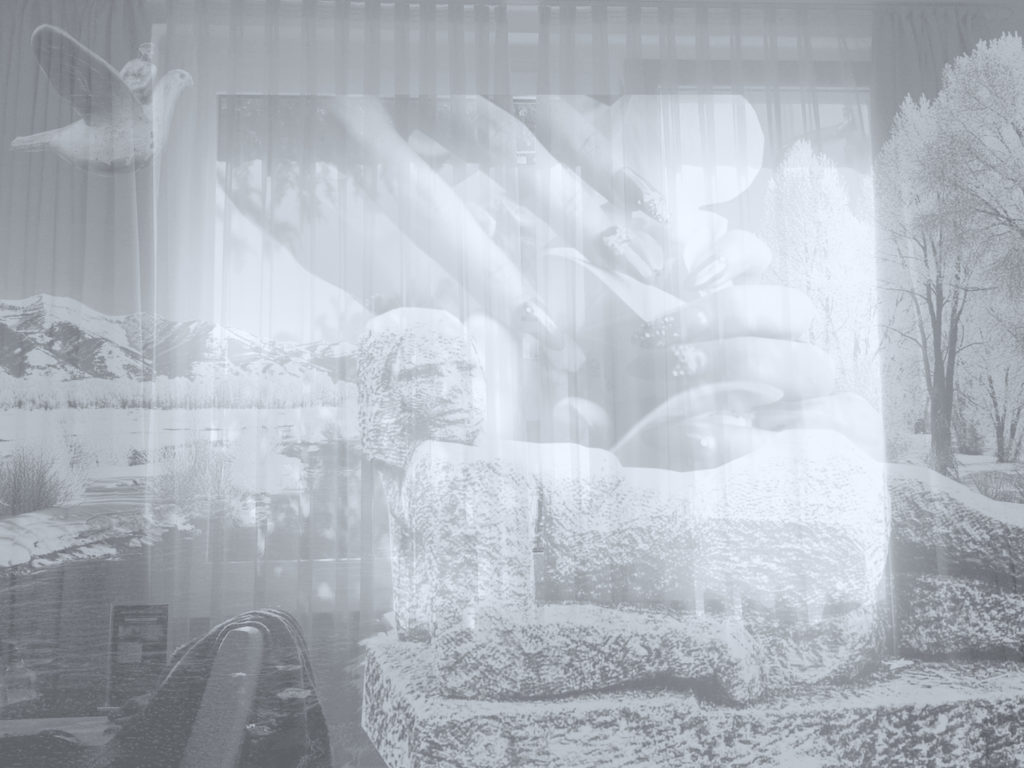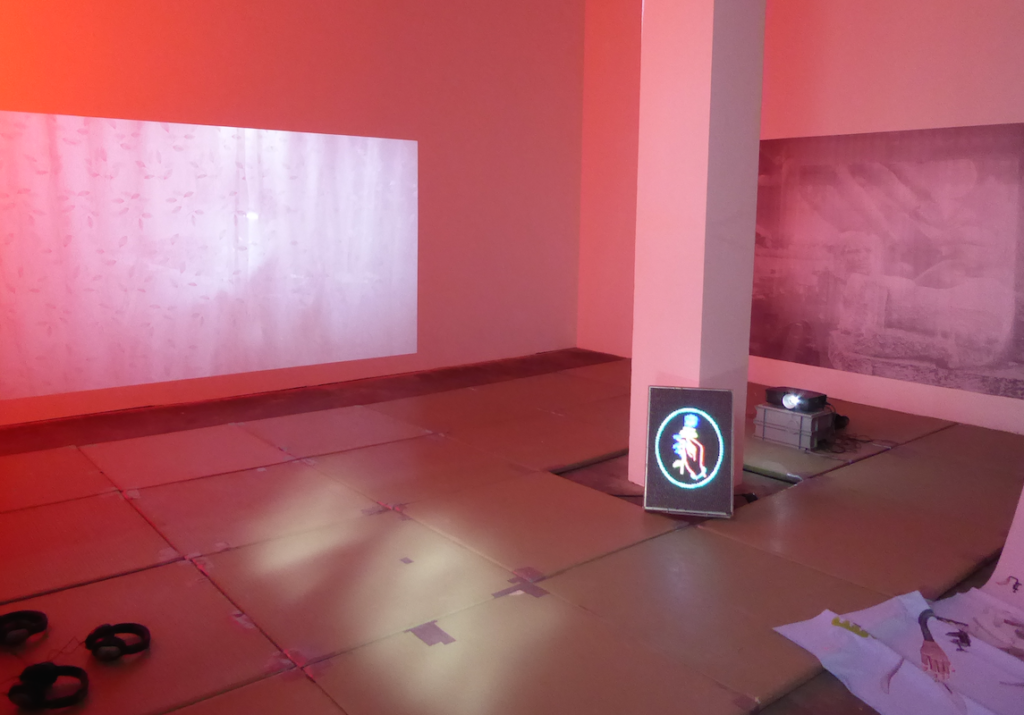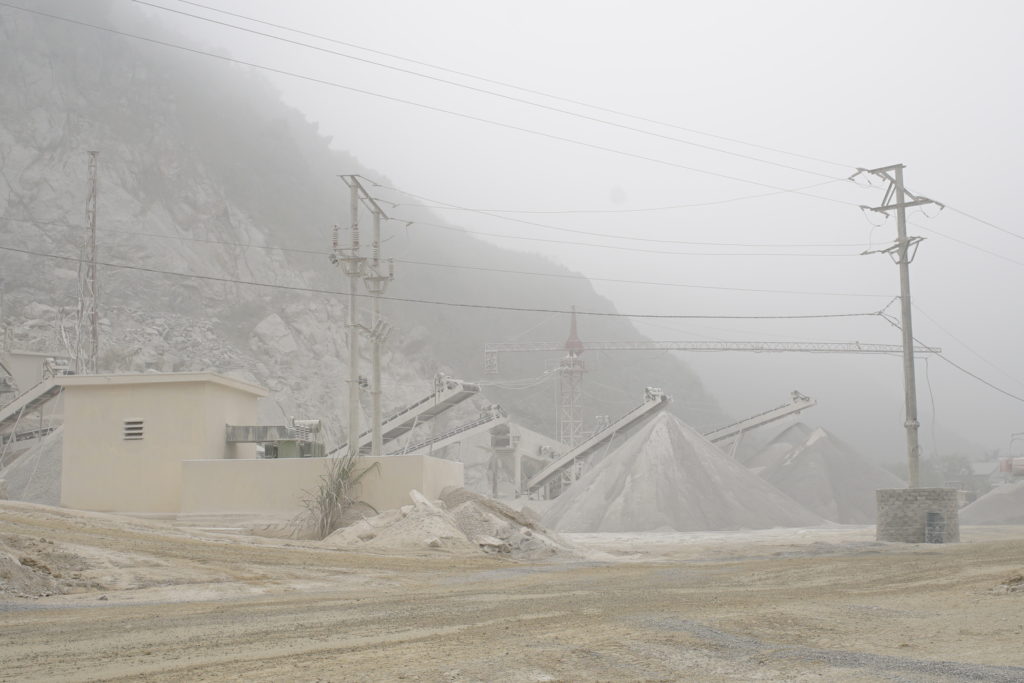Trùng Mù: White Mist in Foreign Country
by Julianne Cordray

In the opening pages of the collaboratively produced publication Nails*hacks*facts*fictions, curator and writer Katja Kobolt’s essay “NailStories,” begins by accentuating the position of the fingernail as interface, or projection screen. Detached hands, dressed in a variety of nail styles, are a recurring, haunting presence in the pages of the publication, as well as in the curtained enclosure of District Berlin’s current installation by artist Nguyen Phuong Linh, Trùng Mù – White Mist in Foreign Country. Within this frame, the exhibition space is co-inhabited by Phuong Linh’s Memory Of the Blind Elephant (2014-2016), Tuan Mami’s In One’s Breath—Nothing Stands Still (2019), and the printed publication.
In this space, hands, whether human or artificial, materialize the presence of otherwise barely visible, or wholly invisible, bodies—particularly those engaged in service work. The repetitive image, in deliberately posed gestures, articulates and solidifies the body’s tactility. Its omnipresence also comes to invoke the so-called “invisible hand” of capitalism—or the capital machine itself—as the system in which the nail industry, its materials and power structures, is embedded. The ambiguity of the severed hand in this context is mirrored by the textures of the three films on view, which are visually connected by impediments to visibility and the pervasiveness of fog – a body composed of contaminants, dust, dead skin, completely without borders to contain it. These connections are elucidated through the ubiquitous realm of nail and cosmetic work, opening up larger conversations around identity and the (gendered, racialized) body in connection to labor, migration and the environment.
The space itself is bounded by and composed of a series of interfaces across a spectrum of opacities. Translucent fabric—silvery, like a screen—hangs in front of the entrance to the exhibition, while sheer coral fabric covers the windows, filtering sunlight through and engulfing the space in a reddish film. The air becomes substance; the sense of touch is evoked not just through the presence of hands, but also the haptic quality of juxtaposed surfaces.
The central film, Trùng Mù (Endless, Sightless) (2018) is a mostly still, semi-opaque image space that at once conjures a beauty salon, a surgical suite, and a funeral parlor. Its opening scene, which is viewed through a sheer floral-printed fabric, depicts the barely discernible motions of an indefinable figure at work on something or someone. The soundscape of the film is steady, mechanic; it buzzes and hums. An overarching sense of emptiness and lifelessness is undermined by the pervasive fog that accumulates in varying levels of opacity, at times culminating in a thick dense cloud of white. The obscuring of vision and the absence of bodies—manifested by an empty bed and furniture covered in white sheets—orchestrate a spectacle of invisibility, particularly within the realm of feminized migrant labor that is being evoked. Here, it is a realm that is revealed to exist outside of time and fixed place. The hazy whiteness of the image sinks into infinity.

This projection is situated adjacent to Phuong Linh’s wallpaper collage, White Mist in Foreign Country (2019), which features a layered gray-scale image—similarly filtered through a translucent curtain—with a centrally positioned, oversized hand that is precisely posed and polished. Two smaller screens in parallel, placed near the floor, meanwhile, display Tuan Mami’s film In One’s Breath—Nothing Stands Still and Phuong Linh’s Memory Of the Blind Elephant, respectively. Like bookends, one film is projected onto the side of an architectural support column and the other inhabits a small screen on its opposite side, across the space. Both present sounds, bodies, and images of the natural landscape in Vietnam. Dust, fog, and white viscosity seep in to illuminate ecologies entrenched in coloniality. The contrast between the sprawling landscapes and the stifling, enclosed interiors of Trùng Mù are faded out by the obstructing elements of dust and murkiness, materialized through industrial processes of extraction. Positioned in this way, with the collage and two films in parallel, the images become extensions of each other, expanding the image space beyond its frame. The mountainous landscape, itself a spectral body behind the fog, is echoed from the wallpaper collage through to Tuan Mami’s film.
Placed on the floor in between the two smaller film screens is a sign advertising “Nails,” followed by an image of a floating hand extending a blue rose, which flashes rhythmically in lights. After a sequence of oscillations, more extensive text begins to blaze across its surface. The speed at which it flickers by and the blurriness of the characters, however, make it difficult to read. Quick glimpses of phrases such as “Be Aware” come into near-focus. The sign, Blue Flamez by Kim Bode, is reminiscent of those that appear in storefront windows of nail salons. However, the space of the commercial LED screen has been hacked and restructured. A message, almost subliminal, seeps in: “… you might not be aware that your hybrid hands and hybrid extensions are holding one another closely.”
Nearby, in a suspended textile printed with images of nail salon equipment, hands and nails— both flesh and synthetic—are objects floating against a cotton-candy-colored background, which take on a clinical, at times menacing, quality. Compounded imagery of fake fingertips and nails capped onto an artificial hand, meanwhile, begin to empty the concept of artificiality of its relevance through sheer redundancy.

Nails, both as embedded surface of the body and prosthetic organ, are porous: a membrane between self and others, between the internal operations of the body and its external appearance. In a similar way, though the space and the works that reside within it communicate boundaries—through screens, curtains, and the sinister, unbounded fog that paradoxically functions in a similar manner—these structures are nonetheless visualized as permeable. The particles of fog—which are also particles of us—are breathed in and absorbed by the skin, ultimately eliciting further interchange between bodies. Through layering, collaging, alternately cloaking and revealing, this process of embodiment is visualized by the enveloping presence of translucent and penetrable interfaces in the space: namely fabric, a similar state of matter, between liquid and solid.
In delving into the history and present of nail and cosmetic work and its ties to toxicity, gender and racial stereotypes, exploitation, and coloniality, the individual and collaborative works address the violence and trauma enacted on bodies. Toxic materials, hierarchical relationships, and oppressive power structures manifest an absorptive omnipresence in the installation of Trùng Mù – White Mist in Foreign Country, which subsequently becomes disarticulated through a process of dissolving the fixity of the body itself. This disjointing of the body from certain inscriptions and norms permits hybrid and multiple subjectivities to form. Through hacking and reconstituting, we are shown that codes and structures—bodies—are left open to coexistent positionalities and alternate embodiments: open to the possibility of tangible exchange.
Trùng Mù – White Mist in Foreign Country ran at District Berlin through June 2, 2019.